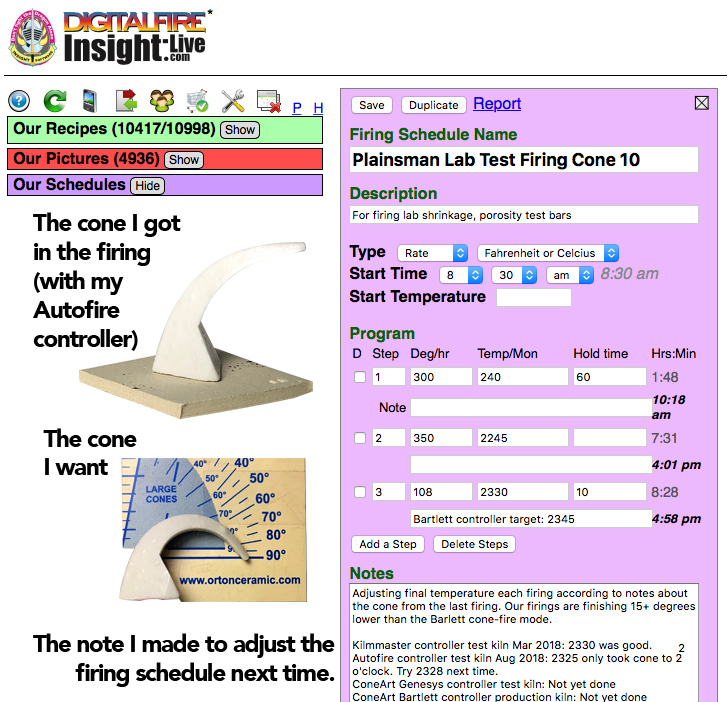| Monthly Tech-Tip | No tracking! No ads! | |
04DSDH - Low Temperature Drop-and-Hold
BQ1000 - Plainsman Electric Bisque Firing Schedule
BRTF05 - Bartlett Fast Glaze Cone 05
BRTF6 - Bartlett Fast Glaze Cone 6
BRTS6 - Bartlett Slow Glaze Cone 6
BTFB04 - Bartlett Fast Bisque Cone 04
BTSB04 - Bartlett Slow Bisque Cone 04
BTSG05 - Bartlett Slow Glaze Cone 05
C10RPL - Plainsman Cone 10R Firing
C5DHSC - Plainsman Cone 5 Drop-and-Hold Slow-Cool
C6DHSC - Plainsman Cone 6 Drop-and-hold, Slow Cool
C6IRED - Cone 6 Iron Reds
C6MSGL1 - Mastering Glazes Cone 6
C6PLST - Plainsman Cone 6 Electric Standard
FSCG1 - Shimbo Crystal Schedule 1
FSCGB1 - Shimbo Crystal Holding Pattern 2
FSCGCL - Shimbo Crystal Celestite Schedule
FSCGWM - Wollast-O-Matte Fara Shimbo Crystalline Glaze
FSCRGL - GC106 Base for Crystalline Glazes
FSHP1 - Shimbo Crystal Holding Pattern 1
FSHP3 - Shimbo Crystal Holding Pattern 3
FSNM5 - Fa's Number Five
MDDCL - Medalta Decal Firing
PLC6CR - Cone 6 Crystal Glaze Plainsman
PLC6DS - Cone 6 Drop-and-Soak Firing Schedule
QICA - Quartz Inversion Cracking Avoider
"C04PLTP" Firing Schedule
Plainsman Low Temperature Drop-and-hold
We use this schedule for cone 06, 05, 04 and 03, adjusting the top-temperature and hold-temperature as needed.
We never use the built-in programs on kiln controllers because this schedule gives better results. We seldom fire cone 06, glazes melt better at 05 and cone 04.
The drop-and-hold temperature if 100F below top. For example, if you are firing to cone 05, then top temp will be about 1860 and the drop-and-hold temp will be about 1760 (according to what your firing cone indicates).
The slower approach at the end is important to even out the kiln chamber, that is why a longer hold is not needed at top temperature. The drop-and-hold is important, this helps heal pinholes and blisters. The cool is freefall. Your rate-of-fall may be quite different than ours, depending on how well your kiln is insulated, how big it is and how heavily it is loaded.
| Step | °C | °F | Hold | Time | |
|---|---|---|---|---|---|
| 1 | 55°C/hr to 121C | 100°F/hr to 250F | 60min | 2:45 | Water smoking step |
| 2 | 194°C/hr to 1004C | 350°F/hr to 1840F | 0 | 7:17 | As fast as your ware can tolerate |
| 3 | 55°C/hr to 1060C | 100°F/hr to 1940F | 10min | 8:27 | Slow approach to top, hold longer for larger kilns (this is for a small test kiln) |
| 4 | 500°C/hr to 1004C | 900°F/hr to 1840F | 30min | 9:04 | Drop 100F and hold |
| 5 | 0°C/hr to 23C | 0°F/hr to 75F | 9:04 |
"Fahrenheit degrees" is not the same as "degrees Fahrenheit". A 100° reading on a Fahrenheit thermometer is equal to a 37° reading on a Celcius thermometer. But "100 Fahrenheit degrees of temperature change" is equivalent "55 Celsius degrees of change". That is an important distinction to understand the above temperature conversions.
Related Information
Program your firings manually, calibrate the final temperature using cones

This picture has its own page with more detail, click here to see it.
Here is an example of our lab firing schedule for cone 10 oxidation (which the cone-fire mode does not do correctly). To actually go to cone 10 we need to manually create a program that fires higher than the built in cone-fire one. Determining how high to go is a matter repeated firings verified using a self-supporting cone (regular cones are not accurate). In our lab we keep notes in the schedule record in our account at insight-live.com. And we have a chart on the wall showing the latest temperature for each of the cones we fire to. What about cone 6? Controllers fire it to 2235, we put down a cone at 2200!
How many degrees between these cone positions?

This picture has its own page with more detail, click here to see it.
I was consistently getting the cone on the left when using a custom-programmed firing schedule to 2204F (for cone 6 with ten minute hold). However Orton recommends that the tip of the self supporting cone should be even with the top of the base (they consider the indicating part of the cone to be the part above the base). So I adjusted the program to finish at 2200F and got the cone on the right. But note: This applies to that kiln at that point in time (with that pyrometer and that firing schedule). Our other test kiln bends the cone to 5 o'clock at 2195F. Since kiln controllers fire cone 6 at 2230 (for the built-in one-button firings) your kiln is almost certainly over firing!
Links
| Recipes |
G2853B - Cone 04 Clear Ravenscrag School Glaze
A Ravenscrag Slip base made by simply mixing it 50:50 with a frit |
| Firing Schedules |
Plainsman Electric Bisque Firing Schedule
Three-step to 1832F |
| Firing Schedules |
Bartlett Fast Bisque Cone 04
120F/hr to 250F, 300/hr to 1000, 150/hr to 1100, 180/hr to 1695, 108/hr to 1945 |
| Typecodes |
Oxidation Firing
|
| By Tony Hansen Follow me on        |  |
Got a Question?
Buy me a coffee and we can talk

https://digitalfire.com, All Rights Reserved
Privacy Policy
